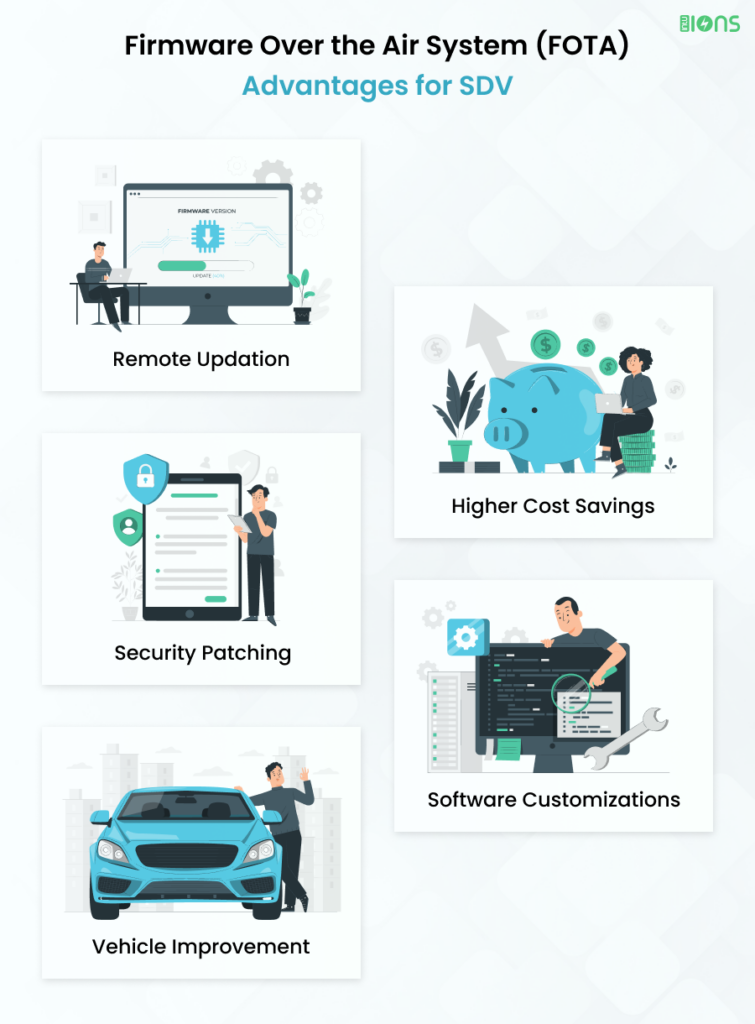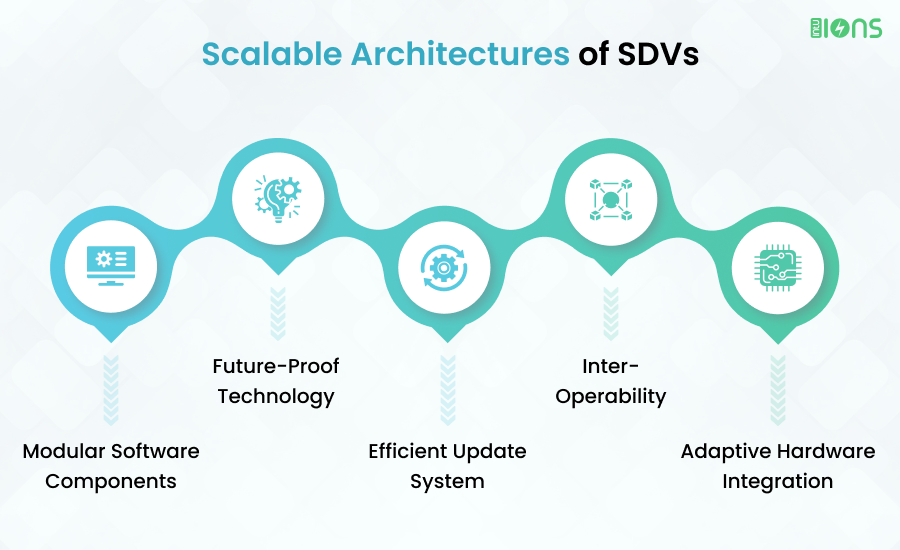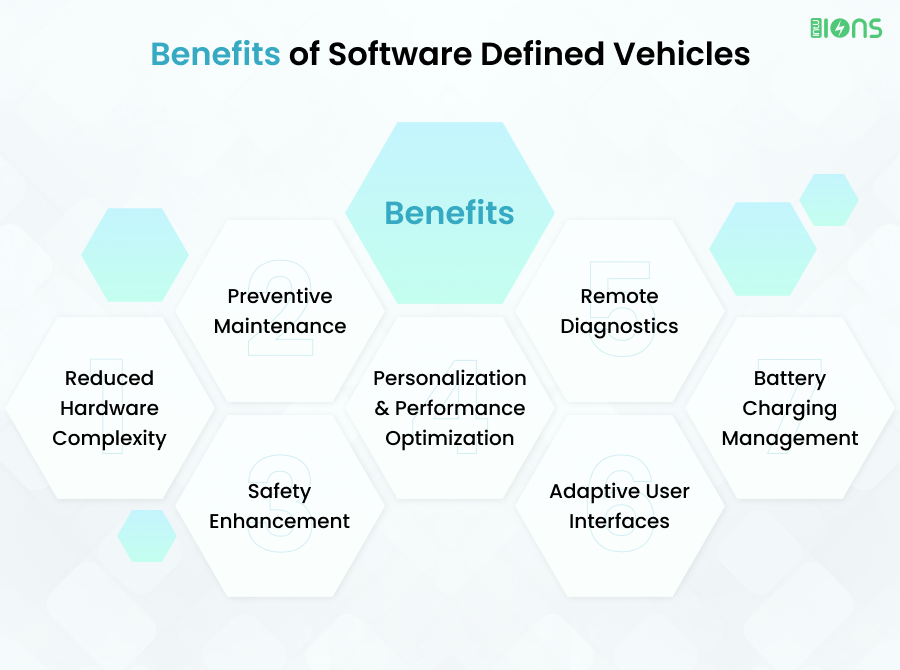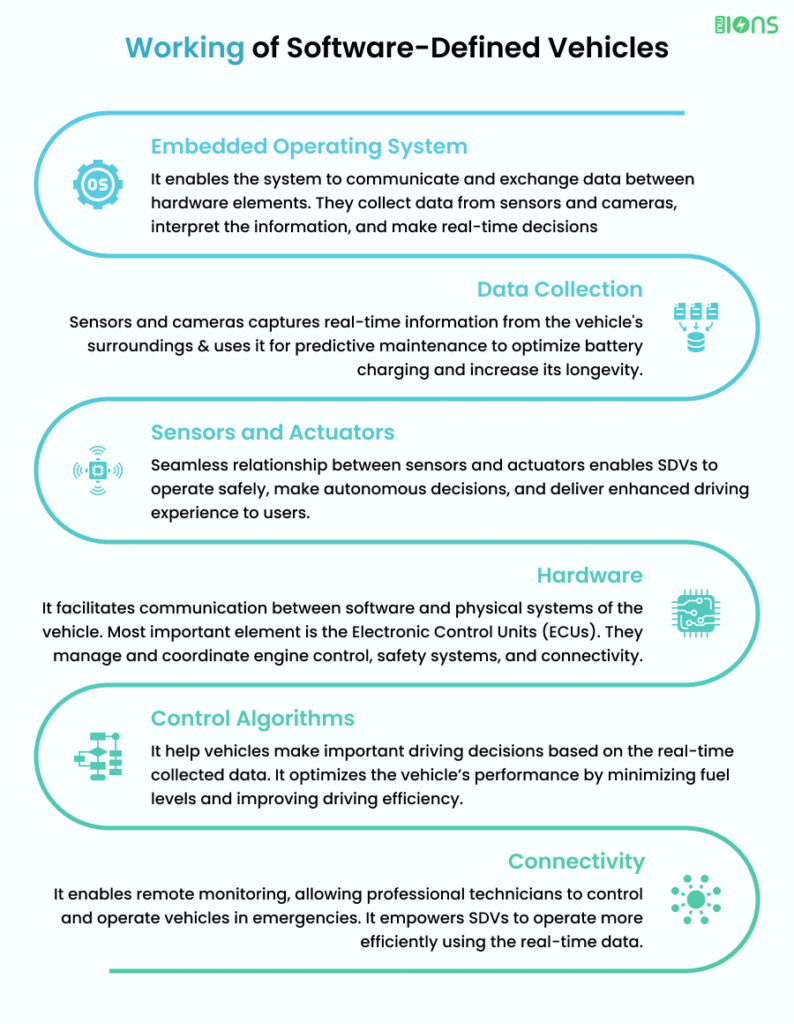Software-Defined Vehicles: A Complete Guide

Explore the world of Software Defined Vehicles (SDVs) in our comprehensive guide. Discover how software is revolutionizing the automotive industry and making vehicles user-friendly and intelligent. Also, learn about Firmware over the Air (FOTA) systems, scalable architectures, and the myriad benefits of SDVs, from preventive maintenance to personalization. Read Now!
The concept of SDVs (Software-Defined Vehicles) has appeared as a transformative force in the rapidly evolving automotive technology. With vehicles transforming into intelligent, connected entities, the use of software in redefining the capabilities of automobiles has become essential and more prevalent.
The software enables vehicles to deliver better performance by optimizing their various parameters based on the collected user data. By providing real-time updates on driving efficiency and safety indicators, automobile software enhances your vehicle safety and amplifies your driving experience.
So, with this comprehensive guide on Software Defined Vehicles, we will help you understand everything about SDV, from its definition to architecture to its working and more. Let us begin!
What is a Software Defined Vehicle?
A Software Defined Vehicle (SDV) is an innovative automotive concept where software is central to the vehicle’s functioning and capabilities. Unlike traditional vehicles, SDVs rely heavily on software to control and manage several vehicle aspects, like engine performance, entertainment systems, safety features, etc.
This software-centric approach used by automobiles enables the use of pragmatic vehicle features like remote updation, personalized vehicle settings, and advanced driver-assistance systems. It allows the automobile to have greater flexibility and adaptability, improving the driving experience for users.
SDVs represent the future of the automotive industry and offer the ability of vehicle evolution and innovation through software updates and integrations.
What is the Role of Software in Vehicle Evolution?
The role of software in the automobile evolution has transcended beyond infotainment systems. Modern vehicles heavily rely on software to upgrade themselves into intelligent and user-friendly machinery.
Unlike conventional automobiles, today’s vehicles are powered with advanced software and sensors that provide numerous driving advantages to the users. They provide systems like (ADAS), such as adaptive cruise control, lane assistance, and automatic emergency braking. These systems enhance vehicle safety by assisting drivers in various situations and reducing the risk of accidents.
Additionally, SDVs leverage software to optimize engine performance, manage battery charging levels, and provide personalized driving experiences to users. Automobile software these days has become so advanced that they can even control ECUs (Engine Control Units). ECUs manage fuel injection, ignition timing, and car emissions, which helps in better fuel economy and reduce environmental impact.
Evolution Table of Software-Defined Vehicles
| Period | Key Milestones in SDV Evolution |
| Pre-2000 | Limited software integration. |
| 2000 | Introduction of electronic control units (ECUs). |
| 2000 – 2010 | Infotainment systems with basic features |
| 2010 – 2020 | Development of fully autonomous prototypes Expansion of V2X (vehicle-to-everything) communicationCybersecurity features incorporation Integration of AI and machine learning continued evolution of cybersecurity measures |
| 2020 – Present | Development of fully autonomous prototypes Expansion of V2X (vehicle-to-everything) communicationCybersecurity features incorporation Integration of AI and machine learning continued evolution of cybersecurity measures |
What is Firmware Over the Air System (FOTA), and Why is it Vital for SDVs?
FOTA, or Firmware Over the Air System, is a technology used in SDVs. It allows manufacturers to update a vehicle’s software remotely, eliminating the need for physical recalls. FOTA helps your vehicles stay updated with current features and the latest security patches.
Using FOTA, you can enjoy several automobile advantages such as:
- Remote Updation
With FOTA, manufacturers can update software directly to vehicles, bypassing the need to visit a dealership or service center. This helps users receive the latest software enhancements without much inconvenience.
- Higher Cost Savings
As the updates are more easily and efficiently delivered to SDVs using FOTA, this significantly reduces the time and cost for both manufacturers and vehicle owners.
- Continuous Vehicle Improvement
By leveraging FOTA-enabled remote updation, vehicles can continuously improve their performance, features, and security. This dynamic approach ensures that vehicles address any potential issues and take corrective measures before the problem intensifies.

- Security Patching
Cybersecurity threats are a concern for vehicles with increasing software integration. Fortunately, FOTA enables manufacturers to swiftly deploy security patches and address vulnerabilities to enhance the overall safety of the vehicle.
- Software Customizations
Vehicle owners can personalize their driving experience with FOTA by upgrading infotainment systems, connectivity features, and other software-related features according to their preferences.
A Quick Look into the Scalable Architecture of SDV’s
Scalable architecture in SDV refers to the flexibility and adaptability of the vehicle’s software to accommodate changes, updates, and expansions seamlessly.
SDVs adopt a scalable architecture that integrates new features and functionalities without making any major hardware changes. This flexibility paves the way for continuous innovation and adaptability, ensuring that vehicles evolve rapidly with technological advancements.
Here are a few essential elements of SDV’s scalable architecture that you should know about
- Modular Software Components
SDVs are built on a modular architecture. This means different software components are decoupled and organized into modules for software development. These modules can be developed, updated, and integrated independently. This modularity enables easy addition or removal of features and ensures higher scalability without overhauling the entire software stack.
- Future-Proof Technology
The scalable architecture of SDV is a future-proof technology as it anticipates future developments and vehicle advancements. You can easily incorporate new software functionalities into the existing software without disrupting the architecture. This, in turn, helps SDVs stay relevant over their operational lifespan.
- Efficient Update System
Firmware over-the-air (FOTA) updates are seamlessly integrated into the scalable architecture. Manufacturers can push updates for specific modules or components without affecting others. This approach streamlines the update process and minimizes downtime.

- Interoperability
SDVs are modular, allowing different modules from different manufacturers to interact harmoniously. Hence, this universal software approach fosters innovation as third-party developers create and integrate compatible software solutions more easily and effectively.
- Adaptive Hardware Integration
Scalable software architecture enables seamless integration of new hardware components as they emerge. Therefore, the scalable design of the software provides an avenue for hardware upgrades without disrupting the software environment.
What are the Benefits of Software Defined Vehicles?
There are many benefits to SDVs, and they are poised to reshape how cars are designed and operated. Here are some noteworthy benefits of Software Defined Vehicles:

| Benefit | Description |
| Preventive Maintenance | SDVs enable predictive maintenance through continuous monitoring and analysis of vehicle components. The installed sensors and data analytic tools detect potential issues and eliminate their existence before they become critical. This substantially allows for timely maintenance and a reduction in downtime. |
| Battery Charging Management | Electric vehicles (EVs) benefit from SDVs by optimizing battery charging and usage. Intelligent software can manage charging cycles, battery health, and energy consumption of vehicles. By optimizing several car parameters, SDVs help vehicles prolong their battery life and improve overall efficiency. |
| Safety Enhancement | SDVs integrate the Advanced Driver Assistance System (ADAS) and autonomous driving features into vehicles that enhance road safety. Cruise control, automatic emergency braking, and lane change warning are some of its features. |
| Reduced Hardware Complexity | SDVs emphasize software capabilities and enable manufacturers to simplify hardware components. As software becomes capable of executing more tasks, the need for complex mechanical systems may decrease. It may also provide additional benefits like reduced vehicle weight and manufacturing costs. |
| Personalization and Performance Optimization | SDVs offer a high degree of customization for users. Drivers can personalize settings, preferences, and vehicle behavior through software adjustments. In addition, SDVs leverage data analytics to optimize fuel efficiency and vehicle performance. The data accumulated by the software generates real-time insights on driving patterns, road conditions, and weather, hugely improving overall vehicle efficiency. |
| Adaptive User Interfaces | SDVs feature user interfaces that adapt to the driver’s needs and preferences. Customizing infotainment systems, displays, and controls using SDV makes the driving experience more intuitive and user-friendly. |
| Remote Diagnostics | SDVs facilitate remote diagnostics and troubleshooting. Manufacturers and service providers can remotely access vehicle data to diagnose potential issues with vehicles. This reduces the need for physical service center visits, saving both parties time and money. |
How Do Software Defined Vehicles (SDVs) Work?
Software Defined Vehicles (SDVs) function through a well-coordinated system. The working of SDVs is divided into four essential systems, namely:
- Embedded Operating System
The Operating System in SDVs functions as the vehicle’s digital brain. It is the core software that manages and coordinates your vehicle’s electronic components, sensors, and actuators.
Embedded OSs enable the system to communicate and exchange data between different hardware elements. They collect data from sensors and cameras, interpret the information, and make real-time decisions that help control crucial aspects of the vehicle.
A good and reliable OS offers a unique experience of controlling essential drive parameters including acceleration, braking, steering, and safety features like adaptive cruise control and lane-keeping assistance.
- Data Collection
In Software Defined Vehicles, data collection refers to a process where a network of sensors and cameras captures real-time information from the vehicle’s surroundings and internal systems.
The sensors and the radar continuously monitor road conditions, traffic, weather, and the vehicle’s performance.
The collected data is further analyzed by the SDV, and instant decisions are made for the safe and efficient operation of the vehicle. Data collection is also used for predictive maintenance as it can collect data to optimize battery charging and increase its longevity.
- Sensors and Actuators Sensors
Actuators and sensors are vital components in SDVs. The sensor of the vehicle which includes radars, digital cameras, and LiDar collects and provides real-time data insights about the vehicle’s surroundings and internal performance.
Conversely, actuators are responsible for translating data from the sensors into action. They control various vehicle functions like steering, acceleration, and braking based on the information received from sensors.
For instance, if a sensor detects an obstacle ahead, actuators come into action by engaging brakes to prevent a collision. This unique relationship between sensors and actuators enables SDVs to operate safely, make autonomous decisions, and deliver enhanced driving experience to users.

- Hardware
Hardware is a critical component of SDVs that facilitates communication between software and physical systems of the vehicle. The most vital hardware element in SDVs is the Electronic Control Units (ECUs). ECUs manage and coordinate functions such as engine control, safety systems, and connectivity.
Apart from that, other hardware elements of SDVs include Sensors, Actuators, Processors, Memory Units, Communication Interfaces, and GPS receivers. These components process data collected by sensors and execute actions based on predefined software instructions.
In all, robust hardware in SDV helps unlock its intelligent and adaptive capabilities and ensures a seamless user experience with optimized performance.
- Control Algorithms
These are the most significant parts of SDVs that work as the brain behind operating the SDVs and making them reliable and efficient. These algorithms help vehicles make important driving decisions based on the real-time collected data.
SDVs constantly gather information from sensors within the vehicle, real-time sensor data, map information, and pre-defined rules. Control algorithms use this data to provide information about the vehicle’s surroundings, current condition, and the road ahead. Further, the data is processed and analyzed to help vehicles make decisions for efficient and autonomous driving.
Other than that, control algorithms also substantially optimize the vehicle’s performance by minimizing fuel levels and improving driving efficiency. Lastly, various SDVs integrate ML and AI techniques into their models. Over time, they learn from their experiences and adapt their decision-making processes. This means as the vehicle gathers more data and encounters different situations, it becomes better at making driving decisions.
- Connectivity
Connectivity in SDVs can be considered as the backbone of their operation. These vehicles are typically equipped with internet connectivity or a link to a central server. This connection serves as a real-time information gateway and constantly feeds SDVs with critical updates and data.
Firstly, SDVs receive real-time updates on traffic information and road conditions. Based on the data, they adapt their route to their destination and make informed driving decisions. Secondly, they receive software updates in real-time that enhance the driving capabilities and safety of the vehicle.
Connectivity also enables remote monitoring, allowing professional technicians to control and operate vehicles in emergencies. Ultimately, connectivity empowers SDVs to operate more efficiently and safely, using the adapted real-time data.
Important Tips on Concerns Related to Cybersecurity and Tackling Them
While SDVs offer numerous benefits, their heavy reliance on software also raises cybersecurity concerns. As vehicles are all connected with software, hackers targeting vehicles could compromise safety systems and gain unauthorized access to sensitive data.
Here are a few ways that can help identify and mitigate security concerns in SDVs:
- Implementing robust data encryption measures
- Employing advanced Intrusion Detection Systems (IDS)
- Conducting regular security audits
- Assessing the security practices of software suppliers
- Ensuring compliance with industry-specific regulations
- Securing over-the-air update mechanisms
Lead the Charge in SDV Technology with Intuitions!
Software Defined Vehicles represent the future of the automobile industry by offering unparalleled potential for innovation and customization. Hence, OEMs must embrace SDV development to stay competitive, enhance user experience, and contribute to a safer and sustainable transportation landscape.
With Intuions, you can fully accelerate your hardware innovations and provide a refined and improved experience to your users. Contact us today to discuss your projects.
